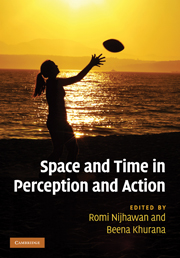Book contents
- Frontmatter
- Contents
- List of contributors
- Acknowledgments
- 1 Space and time: the fabric of thought and reality
- Part I Time–space during action: perisaccadic mislocalization and reaching
- Part II Temporal phenomena: perception
- Part III Temporal phenomena: binding and asynchrony
- Part IV Spatial phenomena: forward shift effects
- Part V Space–time and awareness
- 28 Object updating: a force for perceptual continuity and scene stability in human vision
- 29 A motion illusion reveals the temporally discrete nature of visual awareness
- 30 Priming and retouch in flash-lag and other phenomena of the streaming perceptual input
- Index
- References
30 - Priming and retouch in flash-lag and other phenomena of the streaming perceptual input
from Part V - Space–time and awareness
Published online by Cambridge University Press: 05 October 2010
- Frontmatter
- Contents
- List of contributors
- Acknowledgments
- 1 Space and time: the fabric of thought and reality
- Part I Time–space during action: perisaccadic mislocalization and reaching
- Part II Temporal phenomena: perception
- Part III Temporal phenomena: binding and asynchrony
- Part IV Spatial phenomena: forward shift effects
- Part V Space–time and awareness
- 28 Object updating: a force for perceptual continuity and scene stability in human vision
- 29 A motion illusion reveals the temporally discrete nature of visual awareness
- 30 Priming and retouch in flash-lag and other phenomena of the streaming perceptual input
- Index
- References
Summary
Summary
When rapidly successive objects or object replicas are presented as sensory streams, a stimulus within a stream is perceptually facilitated relative to an otherwise identical stimulus not within the stream. Experiments on perceptual latency priming and flash-lag have convincingly shown this. Unfortunately, no consensus exists on what is (are) the mechanism(s) responsible for in-stream facilitation. Here, I discuss several alternative explanations: perceptual extrapolation of change in the specific properties of continuous stimulation, time-saving for target processing due to the early microgenetic/formation stages for target being completed on pretarget in-stream items, control of focused selective attention by the onsets of stimulus input, and preparation of the nonspecific perceptual retouch by the preceding nontarget input in stream for the succeeding target input in stream. Revisions are outlined to overcome the explanatory difficulties that the retouch theory has encountered in the face of new phenomena of perceptual dissociation.
Introduction
Objects that do not occur in isolation are processed differently compared to when they appear as separate entities. If we compare the visual latency of an object presented alone with the latency of its replica that is presented after another object (which is presented nearby in space and time), we see that the object that comes after having been primed by other input achieves awareness faster (Neumann 1982; Bachmann 1989; Scharlau & Neumann 2003a & b; Scharlau 2004). In a typical experiment, a visual prime stimulus is presented, followed by another stimulus that acts as a backward mask to the prime.
Information
- Type
- Chapter
- Information
- Space and Time in Perception and Action , pp. 536 - 558Publisher: Cambridge University PressPrint publication year: 2010
References
Accessibility standard: Unknown
- 2
- Cited by
